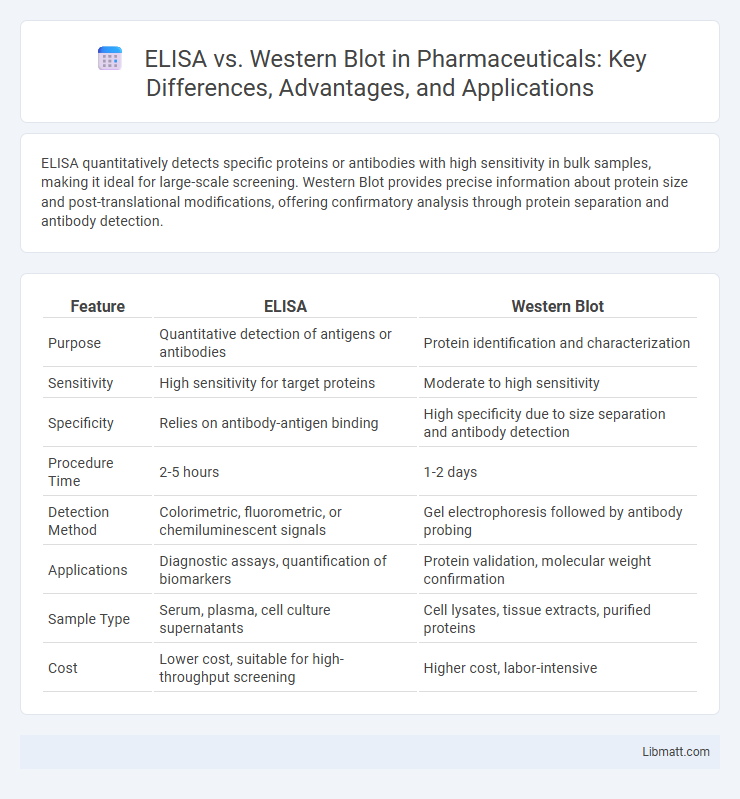ELISA quantitatively detects specific proteins or antibodies with high sensitivity in bulk samples, making it ideal for large-scale screening. Western Blot provides precise information about protein size and post-translational modifications, offering confirmatory analysis through protein separation and antibody detection.
Table of Comparison
| Feature | ELISA | Western Blot |
|---|---|---|
| Purpose | Quantitative detection of antigens or antibodies | Protein identification and characterization |
| Sensitivity | High sensitivity for target proteins | Moderate to high sensitivity |
| Specificity | Relies on antibody-antigen binding | High specificity due to size separation and antibody detection |
| Procedure Time | 2-5 hours | 1-2 days |
| Detection Method | Colorimetric, fluorometric, or chemiluminescent signals | Gel electrophoresis followed by antibody probing |
| Applications | Diagnostic assays, quantification of biomarkers | Protein validation, molecular weight confirmation |
| Sample Type | Serum, plasma, cell culture supernatants | Cell lysates, tissue extracts, purified proteins |
| Cost | Lower cost, suitable for high-throughput screening | Higher cost, labor-intensive |
Introduction to ELISA and Western Blot
Enzyme-Linked Immunosorbent Assay (ELISA) is a highly sensitive technique used to detect and quantify specific proteins or antibodies in samples through antigen-antibody interactions and enzymatic color changes. Western Blot is a protein analysis method that separates proteins by gel electrophoresis, transfers them onto membranes, and uses specific antibodies for detection, providing detailed molecular weight information. Both techniques are essential for immunodetection but differ in methodology, sensitivity, and applications in molecular biology and diagnostics.
Principles of ELISA
ELISA (Enzyme-Linked Immunosorbent Assay) relies on antigen-antibody interactions to detect and quantify specific proteins or antibodies through an enzyme-mediated color change. The assay involves immobilizing antigens or antibodies on a solid surface, followed by binding of the target molecule and a corresponding enzyme-linked antibody for signal amplification. You can leverage ELISA's high sensitivity and quantitative capabilities for precise biomarker analysis compared to the more qualitative nature of Western Blot.
Principles of Western Blot
Western Blot is an analytical technique used to detect specific proteins in a sample through gel electrophoresis, transferring proteins to a membrane, and probing with antibodies specific to the target protein. You benefit from its high specificity and ability to provide molecular weight information, distinguishing it from ELISA, which quantifies proteins in solution without size resolution. The principle revolves around antibody-antigen interactions, combined with chemiluminescent or colorimetric detection methods for visualization.
Key Differences Between ELISA and Western Blot
ELISA quantifies specific proteins or antibodies in samples through enzyme-linked antigen-antibody reactions, allowing high-throughput and quantitative analysis. Western Blot separates proteins by gel electrophoresis prior to antibody detection, providing detailed molecular weight and protein isoform information. While ELISA is ideal for screening and quantification, Western Blot excels in protein verification and characterization.
Applications in Diagnostics
ELISA is widely used for rapid detection and quantification of antibodies, antigens, hormones, and proteins in clinical diagnostics, offering high throughput and sensitivity. Western Blot serves as a confirmatory test providing detailed molecular weight and specificity information, commonly used for diagnosing infectious diseases like HIV and Lyme disease. Your choice depends on whether you require quick screening or precise protein identification in diagnostic workflows.
Sensitivity and Specificity Comparison
ELISA demonstrates higher sensitivity in detecting low-abundance proteins due to its enzyme-amplified signal, making it ideal for quantifying antigen concentrations in complex samples. Western Blot offers superior specificity by separating proteins based on molecular weight and confirming target identity through antibody binding, effectively distinguishing between isoforms and post-translational modifications. While ELISA excels in high-throughput screening with quantitative output, Western Blot remains the gold standard for precise protein characterization and validation.
Workflow and Time Requirements
ELISA involves a straightforward workflow with antigen or antibody coating, blocking, sample incubation, and colorimetric detection, typically completed within 2 to 5 hours. Western Blot requires protein separation by gel electrophoresis, transfer to membranes, blocking, antibody probing, and chemiluminescent or colorimetric detection, extending the assay time to 1 or 2 days. ELISA is more suitable for high-throughput screening due to its rapid workflow, while Western Blot provides detailed protein identification at the cost of longer processing time.
Advantages of ELISA
ELISA offers high sensitivity and specificity for detecting and quantifying proteins, making it ideal for large sample screenings. It is faster, more cost-effective, and easier to automate compared to Western Blot, allowing for higher throughput in laboratories. Your choice of ELISA enables efficient, quantitative analysis with minimal sample preparation and streamlined workflow.
Advantages of Western Blot
Western Blot offers superior specificity by detecting proteins through antibody binding and size separation, minimizing false positives common in ELISA. This technique allows the identification of protein isoforms and post-translational modifications, providing critical insights into protein expression and structure. Western Blot also excels in confirming ELISA results by validating target protein presence with high accuracy.
Choosing the Right Assay for Your Research
Selecting between ELISA and Western Blot depends on your research goals, as ELISA offers high-throughput quantification of specific proteins with excellent sensitivity, making it ideal for measuring protein levels in multiple samples quickly. Western Blot provides detailed information on protein size and post-translational modifications, useful for validating protein identity and assessing expression changes. Consider using ELISA for large-scale protein quantification and Western Blot for qualitative analysis requiring resolution of protein isoforms or verification of antibody specificity.
ELISA vs Western Blot Infographic

 libmatt.com
libmatt.com